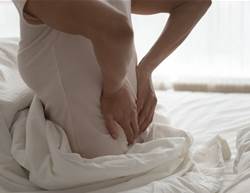Bloating, abdominal pain, gas, and diarrhoea-these are all classic symptoms of irritable bowel syndrome (IBS), an ultra-common digestive condition that affects the large intestine and impacts around one in five Australians. But those symptoms are also signs of a less-recognised condition called small intestinal bacterial overgrowth, also known as SIBO.
SIBO was thought to be rare in the past, and mostly in patients with rheumatic conditions and diabetes, says gastroenterologist Dr Lisa Ganjhu "But there's more awareness now, and it can be seen in people without those conditions," she explains. It's much more prevalent than previously thought, and a growing number of people are being diagnosed with it.
What causes SIBO?
"We all have billions of bacteria in our digestive tract," says Dr Ganjhu says. SIBO happens when there's an excessive amount of gut bacteria in the small intestine, or when bacteria that's normally found in the large intestine is found in the small one, she explains.
How do the bacteria wind up where they don't belong? It happens when there's a problem with "gut motility"-muscle contractions that occur in the gastrointestinal tract when you’re digesting food, Dr Ganjhu says. If these movements in the small intestine don't happen, then bacteria get stuck there and start to reproduce. This is why "in people with SIBO, the nutrients in food aren't absorbed,” Dr Ganjhu says. As a result, people who have SIBO tend to also experience unexplained weight loss and nutritional deficiencies. In some cases, they may even develop osteoporosis.
Lots of factors can impair gut motility. Usually, they're related to chronic health conditions like diabetes or Crohn's disease, or previous surgeries that affected the bowels. But now, experts are realising that movement issues can also be caused by "alcohol, travel, stress, antibiotic use, NSAID use-essentially anything that disrupts the microflora," Dr Ganjhu says.
Common SIBO symptoms
The symptoms for SIBO are very similar to IBS, which is why it can be hard to diagnose. Some research shows that SIBO is actually one of the causes of IBS symptoms. The tricky part is that SIBO symptoms can also present differently in each individual, depending on how their bacterial overgrowth looks like. For example, people who have SIBO and produce more methane gas might have constipation versus diarrhea, according to a 2017 study in Gut Liver.
SIBO symptoms might include:
- Flatulence
- Abdominal pain or discomfort
- Diarrhoea or constipation
- Nausea
- Fatigue
- Unintentional weight loss
- Nutritional deficiencies, especially in vitamin B12, fat-soluble vitamins (vitamin A, D, E, and K), and iron
How is SIBO diagnosed?
If you suspect you have SIBO, Dr Ganjhu advises you see a doctor right away and not try to self diagnose. “It’s always good to see a gastroenterologist or your doctor first because you don’t know if the bloating is from SIBO or something else. People can have bloating from ovarian cancer, or you might be taking medication that makes you bloated,” Dr Ganjhu says.
There are two different tests for SIBO that your gastroenterologist will use to diagnose your condition: the breath test and a fecal test. “Some people do a bowel sample, but it’s hard to get a sterile sample, and there are few places around the country that do a stool test,” Dr Ganjhu says. For this reason, many people opt to do the SIBO breath test, also known as the hydrogen breath test or the lactulose breath test. “First, you blow into a bag, and then you drink a solution and that solution has lactulose. After drinking the solution, you blow into a second bag. The sugar in the solution is tagged with a marker, and if that number is high, it’s usually SIBO,” Dr Ganjhu says.
When the bacteria in your gut digest food, they produce hydrogen and methane gas that you exhale through your lungs. So when you blow into the first bag, your doctor is testing for your hydrogen and methane levels. These levels indicate how much gas the bacteria in your intestines are creating. The solution you drink has lactulose, which your body can’t digest but SIBO bacteria can metabolize it, producing high levels of hydrogen-a sign of SIBO.
Here are some guidelines to follow before you take the SIBO breath test. Be sure to wait at least 28 days to do the breath test after taking antibiotics or probiotics, and 14 days after doing a colonoscopy.
A day before your test, avoid eating or drinking:
- Foods with carbohydrates and starches that are harder to digest, like beans, nuts and seeds, whole grains, vegetable juices, kale, and
- Milk, cheese, yoghurt, butter, and other dairy
- Soft drink and vegetable and fruit juices
12 hours before your test:
- Stop eating and drinking
- Take your usual prescribed medications
- Don’t chew gum or eat breath mints and candies
- Avoid smoking or chewing tobacco
How do you treat SIBO?
If you’ve been diagnosed with SIBO, your doctor will most likely prescribe antibiotics called rifaximin (brand name Xifaxan) to help restore a balance of good and bad bacteria in the gut. "The mainstay of therapy is either antibiotics, probiotics, or a combination of the two, along with removal of the offending agent that causes SIBO," Dr Ganjhu says.
The antibiotics work to treat symptoms like abdominal pain and diarrhoea and to reduce bacterial overgrowth. But Dr Ganjhu says using antibiotics is a short-term plan. "The problem with antibiotic therapy is that SIBO often returns so you need to retreat," she says. Moreover, antibiotics are sometimes ineffective when treating bacteria that produce methane.
“Methane can be really hard to treat. The antibiotic, neomycin, might be added. Some doctors will recommend probiotics instead. There are few probiotics that work, however, so it’s a trial and error process. You have to re-inoculate the good bacteria,” Dr Ganjhu explains. "Since we all have our own microbiome fingerprint, everyone is different and different probiotics work for different people."
There are a variety of foods that are natural sources of probiotics, but it’s also important to eat prebiotics that support the growth of good bacteria. "Probiotics in the bifidobacteria family are the most gut-friendly. In a majority of people, the bifidobacteria work, and in others, the lactobacillus family work better. Often, you need to try it out to find the right bug. Sometimes, you may feel worse before you feel better," Dr Ganjhu says.
Dr Ganjhu also recommends patients with SIBO to work with a dietitian to follow a low-FODMAP diet. “The low-FODMAP diet has been proven to help with IBS symptoms and SIBO. By working with a dietitian, you can also address nutritional deficiencies caused by SIBO,” Dr Ganjhu says.
The low-FODMAP diet has been used to help treat IBS symptoms such as gas, bloating, and diarrhoea. FODMAPs are a type of carbohydrates that can cause abdominal discomfort. These carbs include fermentable oligosaccharides, disaccharides, monosaccharides, and polyols. These foods include beans, onions, garlic, cauliflower, mushrooms, yoghurt, cheese, honey, and apples. "By removing the high-FODMAP foods from your diet, you can reduce bloating due to the poor digestion," Dr Ganjhu explains.
While it might seem like you're eliminating a lot of foods at once, you're restricting them for only a period of time-until you can figure out what foods are triggering SIBO. Then, you can reintroduce the other foods that aren't affecting you. Plus, there are plenty of other delicious vegetables, fruits, and dairy-free alternatives you can enjoy on the low-FODMAP diet.
That said, treating SIBO takes patience as it involves a lot of trial and error with diet and medication, but there are steps you can take to manage your symptoms and get the condition under control. Dr Ganjhu says, “By supporting a healthy gut, you’ll also see improvements in other areas of your health since the gut is connected to major bodily functions.”






.png&h=193&w=250&c=1&s=1)
.png&h=193&w=250&c=1&s=1)


